Blog
What Is Freiberg’s Disease?
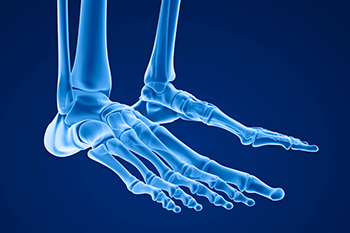
Freiberg’s disease is a painful foot condition that affects the metatarsal bones, most often the second metatarsal located near the base of the toes. It occurs when the blood supply to the bone is disrupted, leading to tissue damage and collapse of the bone surface. Causes may include repetitive stress, trauma, or genetic predisposition, and it most often develops in adolescents and young adults. Symptoms include pain in the ball of the foot, swelling, stiffness, and difficulty bearing weight or wearing shoes comfortably. A podiatrist can help by diagnosing the condition, providing orthotics, recommending activity modifications, or discussing surgical options in severe cases. If you have persistent foot pain, it is suggested that you promptly consult a podiatrist who can accurately diagnose the problem and offer effective relief and management solutions.
Some foot conditions may require additional professional care. If you have any concerns, contact Jack A. Sasiene, DPM of Texas. Our doctor can provide the care you need to keep you pain-free and on your feet.
Rare Foot Conditions
The majority of foot conditions are common and can be treated by a podiatrist. Standard diagnostic procedures are generally used to identify specific conditions and treatment can be rendered. A podiatrist also treats rare foot conditions which can be difficult to diagnose and may need extra attention and care.
There are many rare foot conditions that can affect children. Some of these can include:
- Freiberg’s disease
- Kohler’s disease
- Maffucci syndrome
Freiberg’s disease - This can be seen as a deterioration and flattening of a metatarsal bone that exists in the ball of the foot. It typically affects pre-teen and teenage girls, but can affect anyone at any age. Symptoms that can accompany this can be swelling, stiffness, and the patient may limp.
Kohler’s disease - This often targets the bone in the arch of the foot and affects younger boys. It can lead to an interruption of the blood supply which ultimately can lead to bone deterioration. The patient may limp or experience tenderness, swelling, and redness.
Maffucci syndrome - This affects the long bones in a child’s foot leading to the development of abnormal bone lesions. They are benign growths and typically develop in early childhood and the bones may be susceptible to breaking.
A podiatrist can properly diagnose and treat all types of rare foot conditions. If your child is affected by any of these symptoms or conditions, please don’t hesitate to call our office so the correct treatment method can begin.
If you have any questions, please feel free to contact our office located in Lake Jackson, TX . We offer the newest diagnostic and treatment technologies for all your foot care needs.
Looking After a Broken Foot
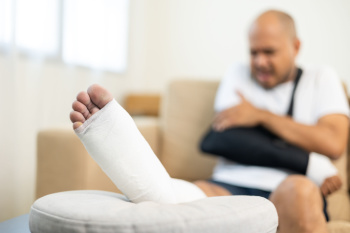
A fracture in the foot can result from a sudden injury, an awkward step, or repeated stress on the bones. Signs may include sharp pain, swelling, bruising, or trouble standing and walking. Because the foot has many small bones that work together for balance and movement, getting the right care is essential. Treatment varies depending on how serious the break is. Some patients may need only rest, a walking boot, or crutches, while others may require a cast, or, in more complicated cases, surgery to realign the bones. Elevating the foot and keeping weight off it helps with recovery. Healing usually takes several weeks, but following a podiatrist’s guidance supports a smoother return to activity. If you think you may have fractured your foot, it is recommended that you promptly visit a podiatrist for an accurate diagnosis and care plan.
A broken foot requires immediate medical attention and treatment. If you need your feet checked, contact Jack A. Sasiene, DPM from Texas. Our doctor can provide the care you need to keep you pain-free and on your feet.
Broken Foot Causes, Symptoms, and Treatment
A broken foot is caused by one of the bones in the foot typically breaking when bended, crushed, or stretched beyond its natural capabilities. Usually the location of the fracture indicates how the break occurred, whether it was through an object, fall, or any other type of injury.
Common Symptoms of Broken Feet:
- Bruising
- Pain
- Redness
- Swelling
- Blue in color
- Numbness
- Cold
- Misshapen
- Cuts
- Deformities
Those that suspect they have a broken foot shoot seek urgent medical attention where a medical professional could diagnose the severity.
Treatment for broken bones varies depending on the cause, severity and location. Some will require the use of splints, casts or crutches while others could even involve surgery to repair the broken bones. Personal care includes the use of ice and keeping the foot stabilized and elevated.
If you have any questions, please feel free to contact our office located in Lake Jackson, TX . We offer the newest diagnostic and treatment technologies for all your foot care needs.
Causes and Care for Pain on the Top of the Foot
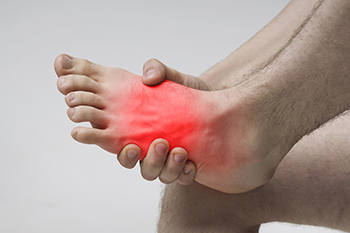
Pain on the top of the foot can result from several conditions. One common cause is wearing shoes that are too tight across the laces, which can irritate nerves and tendons. Overuse injuries, such as tendonitis or stress fractures, also frequently affect this area, especially in athletes and runners. Arthritis, ganglion cysts, and nerve entrapment may also lead to discomfort on the top of the foot. Identifying the exact source of pain is important in order to guide treatment. Rest, wearing supportive footwear, and anti-inflammatory measures may help relieve mild symptoms. Custom orthotics, bracing, or targeted exercises can provide additional support when needed. In more severe cases, surgery may be required. If you are dealing with ongoing pain on the top of your foot, it is suggested that you schedule an appointment with a podiatrist for an accurate diagnosis and individualized treatment plan.
Foot Pain
Foot pain can be extremely painful and debilitating. If you have a foot pain, consult with Jack A. Sasiene, DPM from Texas. Our doctor will assess your condition and provide you with quality foot and ankle treatment.
Causes
Foot pain is a very broad condition that could be caused by one or more ailments. The most common include:
- Bunions
- Hammertoes
- Plantar Fasciitis
- Bone Spurs
- Corns
- Tarsal Tunnel Syndrome
- Ingrown Toenails
- Arthritis (such as Gout, Rheumatoid, and Osteoarthritis)
- Flat Feet
- Injury (from stress fractures, broken toe, foot, ankle, Achilles tendon ruptures, and sprains)
- And more
Diagnosis
To figure out the cause of foot pain, podiatrists utilize several different methods. This can range from simple visual inspections and sensation tests to X-rays and MRI scans. Prior medical history, family medical history, and any recent physical traumatic events will all be taken into consideration for a proper diagnosis.
Treatment
Treatment depends upon the cause of the foot pain. Whether it is resting, staying off the foot, or having surgery; podiatrists have a number of treatment options available for foot pain.
If you have any questions, please feel free to contact our office located in Lake Jackson, TX . We offer the newest diagnostic and treatment technologies for all your foot care needs.
Are Bunions Affecting Your Everyday Life?
When Toenails Become Infected by Fungus
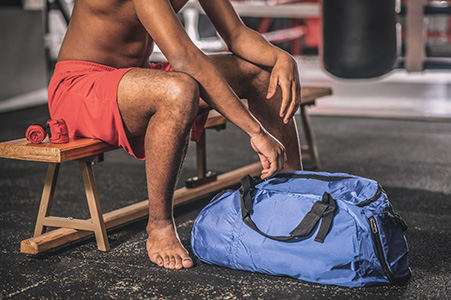
Onychomycosis, also called tinea unguium, is a fungal infection that affects the toenails. It often begins as a small white or yellow spot under the nail and gradually spreads, causing the nail to thicken, change color, and become brittle. Over time, the nail may crumble, separate from the nail bed, or cause discomfort when walking or wearing shoes. Several factors raise the risk of developing this condition. Warm, moist environments, such as locker rooms and around public pools, encourage fungal growth. Wearing tight shoes, having diabetes, reduced circulation, or a weakened immune system also makes infection more likely. Because toenail fungus rarely clears on its own, professional treatment is important. Options may include oral or topical antifungal medications or removal of severely damaged nails. If you notice changes in your toenails that suggest infection, it is suggested that you see a podiatrist for a diagnosis and appropriate treatment.
If left untreated, toenail fungus may spread to other toenails, skin, or even fingernails. If you suspect you have toenail fungus it is important to seek treatment right away. For more information about treatment, contact Jack A. Sasiene, DPM of Texas. Our doctor can provide the care you need to keep you pain-free and on your feet.
Symptoms
- Warped or oddly shaped nails
- Yellowish nails
- Loose/separated nail
- Buildup of bits and pieces of nail fragments under the nail
- Brittle, broken, thickened nail
Treatment
If self-care strategies and over-the-counter medications does not help your fungus, your podiatrist may give you a prescription drug instead. Even if you find relief from your toenail fungus symptoms, you may experience a repeat infection in the future.
Prevention
In order to prevent getting toenail fungus in the future, you should always make sure to wash your feet with soap and water. After washing, it is important to dry your feet thoroughly especially in between the toes. When trimming your toenails, be sure to trim straight across instead of in a rounded shape. It is crucial not to cover up discolored nails with nail polish because that will prevent your nail from being able to “breathe”.
In some cases, surgical procedure may be needed to remove the toenail fungus. Consult with your podiatrist about the best treatment options for your case of toenail fungus.
If you have any questions please contact our office located in Lake Jackson, TX . We offer the newest diagnostic and treatment technologies for all your foot and ankle needs.
The Importance of Shoes That Fit Properly
 Properly fitting shoes have a larger impact on foot health than many people realize. The shape and size of your foot change over time because ligaments and soft tissues relax and stretch as you age. Having foot measurements done annually or even twice a year can help you keep track of the right shoe size for you. Making sure your toes can move freely inside your shoe is important. If your toes don’t have enough room, this could lead to corns, calluses, or deformed toes. Ill-fitting shoes can also cause complications such as bunions, Morton’s neuroma, or plantar fasciitis. Wearing high heels also increases the risk of painful foot conditions because of the pressure that is put on the forefoot. If you would like to learn more about how to find your proper shoe size, it is suggested you consult with a podiatrist.
Properly fitting shoes have a larger impact on foot health than many people realize. The shape and size of your foot change over time because ligaments and soft tissues relax and stretch as you age. Having foot measurements done annually or even twice a year can help you keep track of the right shoe size for you. Making sure your toes can move freely inside your shoe is important. If your toes don’t have enough room, this could lead to corns, calluses, or deformed toes. Ill-fitting shoes can also cause complications such as bunions, Morton’s neuroma, or plantar fasciitis. Wearing high heels also increases the risk of painful foot conditions because of the pressure that is put on the forefoot. If you would like to learn more about how to find your proper shoe size, it is suggested you consult with a podiatrist.
Getting the right shoe size is an important part of proper foot health. Seek the assistance of Jack A. Sasiene, DPM from Texas. Our doctor will provide the care you need to keep you pain-free and on your feet.
Getting the Right Shoe Size
There are many people who wear shoes that are the incorrect size, negatively affecting their feet and posture. Selecting the right shoes is not a difficult process, so long as you keep several things in mind when it comes to choosing the right pair.
- When visiting the shoe store, use the tools available to measure your foot.
- Be sure there is ‘wiggle room’. There should be about an inch between your toes and the tip of your shoes.
- Do not always assume you are the same size, as manufacturers run differently.
- Purchase shoes later in the day, as your feet swell as the day progresses.
- If a shoe is not comfortable, it is not suitable. Most shoes can’t be ‘broken in’, and comfort should be the ultimate goal when it comes to choosing the right pair of shoes
As our feet hold our body weight and keep us moving, it is important to treat them right. Picking the right pair of shoes can provide your feet comfort and mobility without pain.
If you have any questions, please feel free to contact our office located in Lake Jackson, TX . We offer the newest diagnostic and treatment technologies for all your foot care needs.
Gout and Ways to Manage It

Gout is a form of arthritis that occurs when uric acid builds up in the body, forming crystals in the joints, most commonly affecting the big toe. It can cause sudden, intense pain, swelling, redness, and warmth in the affected area, often making walking or standing difficult. Causes include high purine foods, excessive alcohol consumption, obesity, and certain medications. Risk factors involve family history, age, and chronic health conditions such as kidney disease. A podiatrist can help diagnose gout, provide treatments to relieve pain and inflammation, and recommend lifestyle modifications to reduce flare ups. If you have pain in your big toe, it is suggested that you consult a podiatrist who can accurately diagnose gout, and offer effective relief and management tips.
Gout is a painful condition that can be treated. If you are seeking treatment, contact Jack A. Sasiene, DPM from Texas. Our doctor will treat your foot and ankle needs.
What Is Gout?
Gout is a form of arthritis that is characterized by sudden, severe attacks of pain, redness, and tenderness in the joints. The condition usually affects the joint at the base of the big toe. A gout attack can occur at any random time, such as the middle of the night while you are asleep.
Symptoms
- Intense Joint Pain - Usually around the large joint of your big toe, and it most severe within the first four to twelve hours
- Lingering Discomfort - Joint discomfort may last from a few days to a few weeks
- Inflammation and Redness -Affected joints may become swollen, tender, warm and red
- Limited Range of Motion - May experience a decrease in joint mobility
Risk Factors
- Genetics - If family members have gout, you’re more likely to have it
- Medications - Diuretic medications can raise uric acid levels
- Gender/Age - Gout is more common in men until the age of 60. It is believed that estrogen protects women until that point
- Diet - Eating red meat and shellfish increases your risk
- Alcohol - Having more than two alcoholic drinks per day increases your risk
- Obesity - Obese people are at a higher risk for gout
Prior to visiting your podiatrist to receive treatment for gout, there are a few things you should do beforehand. If you have gout you should write down your symptoms--including when they started and how often you experience them, important medical information you may have, and any questions you may have. Writing down these three things will help your podiatrist in assessing your specific situation so that he or she may provide the best route of treatment for you.
If you have any questions, please feel free to contact our office located in Lake Jackson, TX . We offer the newest diagnostic and treatment technologies for all your foot care needs.
When the Big Toe Stops Bending
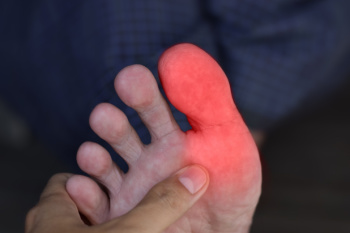
Hallux rigidus is a form of arthritis that affects the big toe joint, making it stiff and painful. The condition often begins with mild discomfort when walking or bending the toe, but over time the joint loses flexibility. People may notice swelling, difficulty wearing certain shoes, or pain that worsens with activity. In advanced cases, even standing can become uncomfortable as the joint becomes increasingly rigid. This problem usually develops from wear and tear on the joint, past injuries, or inherited foot structure. Because the big toe plays a key role in movement, hallux rigidus can significantly affect mobility and daily comfort. Early treatment may include anti-inflammatory medication, shoe modifications, or custom orthotics to ease pressure. If the joint damage is more severe, surgery may be considered. If you have pain in your big toe joint, it is suggested that you see a podiatrist to ensure the condition is managed properly, mobility preserved, and pain reduced.
Arthritis can be a difficult condition to live with. If you are seeking treatment, contact Jack A. Sasiene, DPM from Texas. Our doctor can provide the care you need to keep you pain-free and on your feet.
Arthritic Foot Care
Arthritis is a term that is commonly used to describe joint pain. The condition itself can occur to anyone of any age, race, or gender, and there are over 100 types of it. Nevertheless, arthritis is more commonly found in women compared to men, and it is also more prevalent in those who are overweight. The causes of arthritis vary depending on which type of arthritis you have. Osteoarthritis for example, is often caused by injury, while rheumatoid arthritis is caused by a misdirected immune system.
Symptoms
- Swelling
- Pain
- Stiffness
- Decreased Range of Motion
Arthritic symptoms range in severity, and they may come and go. Some symptoms stay the same for several years but could potentially get worse with time. Severe cases of arthritis can prevent its sufferers from performing daily activities and make walking difficult.
Risk Factors
- Occupation – Occupations requiring repetitive knee movements have been linked to osteoarthritis
- Obesity – Excess weight can contribute to osteoarthritis development
- Infection – Microbial agents can infect the joints and trigger arthritis
- Joint Injuries – Damage to joints may lead to osteoarthritis
- Age – Risk increases with age
- Gender –Most types are more common in women
- Genetics – Arthritis can be hereditary
If you suspect your arthritis is affecting your feet, it is crucial that you see a podiatrist immediately. Your doctor will be able to address your specific case and help you decide which treatment method is best for you.
If you have any questions please feel free to contact our office located in Lake Jackson, TX . We offer the newest diagnostic tools and technology to treat your foot and ankle needs.
Essential Foot Care Tips for Diabetic Patients
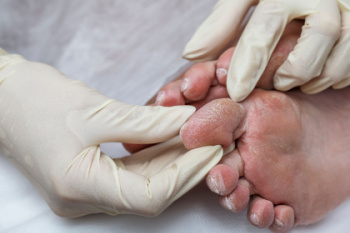
Keeping feet healthy with diabetes is vital to prevent complications such as infections or ulcers. Simple daily habits can make a big difference. Check your feet every day for cuts, blisters, or changes in skin color. Avoid walking barefoot to reduce the risk of injury or infection. Always wear shoes that fit well to protect your feet and prevent pressure points. Additionally, trim toenails straight across to avoid ingrown nails and irritation. A podiatrist can provide regular foot exams, detect problems early, and offer professional care tailored to your needs. If you have diabetes, it is strongly suggested that you are under the care of a podiatrist who can help you to manage this serious condition.
Diabetic foot care is important in preventing foot ailments such as ulcers. If you are suffering from diabetes or have any other concerns about your feet, contact Jack A. Sasiene, DPM from Texas. Our doctor can provide the care you need to keep you pain-free and on your feet.
Diabetic Foot Care
Diabetes affects millions of people every year. The condition can damage blood vessels in many parts of the body, especially the feet. Because of this, taking care of your feet is essential if you have diabetes, and having a podiatrist help monitor your foot health is highly recommended.
The Importance of Caring for Your Feet
- Routinely inspect your feet for bruises or sores.
- Wear socks that fit your feet comfortably.
- Wear comfortable shoes that provide adequate support.
Patients with diabetes should have their doctor monitor their blood levels, as blood sugar levels play such a huge role in diabetic care. Monitoring these levels on a regular basis is highly advised.
It is always best to inform your healthcare professional of any concerns you may have regarding your feet, especially for diabetic patients. Early treatment and routine foot examinations are keys to maintaining proper health, especially because severe complications can arise if proper treatment is not applied.
If you have any questions, please feel free to contact our office located in Lake Jackson, TX . We offer the newest diagnostic and treatment technologies for all your foot care needs.
Are You Suffering From Ingrown Toenails?
More...
Common Reasons for Swollen Feet and Ankles
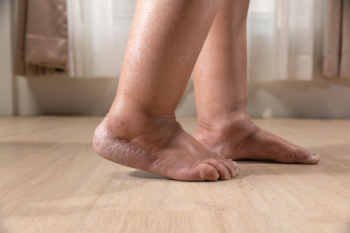
Swollen feet can result from a variety of causes. One common reason is pregnancy, especially during the third trimester, as the body produces extra blood and fluid retention occurs. This can lead to swelling in the feet and ankles, particularly when standing for long periods of time, or in hot weather. Another cause of swollen feet is injury, such as a sprained ankle. Damage to the injured ligaments can lead to fluid accumulation in the affected area as the body works to heal. Venous insufficiency is another contributor to swollen feet. Damaged veins cause blood to pool in the feet and ankles, resulting in swelling. In some cases, swelling can indicate more serious health issues, including heart, kidney, liver disease, or even blood clots. If you have unexplained swelling in the feet, it is suggested that you schedule an appointment with a podiatrist for a diagnosis and appropriate treatment options.
Swollen feet can be a sign of an underlying condition. If you have any concerns, contact Jack A. Sasiene, DPM of Texas. Our doctor can provide the care you need to keep you pain-free and on your feet.
Swollen feet are a common ailment among pregnant women and people who stand or sit for extended periods. Aging may increase the possibility of swollen feet and patients who are obese often notice when their feet are swelling too. There may be medical reasons why swollen feet occur:
- Phlebitis - A condition that causes the veins to become inflamed and can also cause leg pain.
- Liver disease - This may lead to low blood levels of albumin which is a protein. This can cause fluid in the blood to pass into the tissues and several areas of the body can become swollen.
- Heart failure - When the heart doesn’t pump properly the blood that is normally pumped back to the heart can pool in the veins of the legs causing swollen feet.
- Kidney disease - One of the main functions of the kidneys is releasing excess fluid in the body. This type of condition can make it difficult for the kidneys to function properly, and as a result the feet may become swollen.
- Deep-vein thrombosis (DVT)- This is a serious condition where blood clots form in the veins of the legs. They can block the return of blood from the legs to the heart which may cause the feet to swell. It is important to be treated by a podiatrist if this condition is present.
Swollen feet can also be caused by bone and tendon conditions, including fractures, arthritis, and tendinitis. Additionally, there may be skin and toenail conditions and an infection may cause the feet to swell. Patients who take medicine to treat high blood pressure may be prone to getting swollen feet.
Many patients elevate their feet to help relieve the swelling and this is generally a temporary remedy. When a podiatrist is consulted the reason behind the swelling can be uncovered and subsequently treated.
If you have any questions please contact our office located in Lake Jackson, TX . We offer the newest diagnostic and treatment technologies for all your foot and ankle needs.
Reasons Your Feet May Feel Like They Are Burning

Burning feet can be a sign of peripheral neuropathy, which involves damage to the nerves that extend into the feet. One cause is diabetic neuropathy, where high blood sugar harms nerve fibers over time, leading to burning, tingling, or numbness. Alcohol abuse can also damage nerves through oxidative stress. This condition occurs when the body accumulates too many unstable molecules that injure healthy cells, including nerve tissue. Another cause of burning feet is amyloid neuropathy. This develops when abnormal proteins, called amyloid, collect in nerve tissues and interfere with normal nerve function. Symptoms include burning sensations, loss of balance, or numbness in the feet. The discomfort from these conditions often intensifies at night, when cooler temperatures and less distraction may heighten pain awareness. A podiatrist can evaluate these symptoms and provide appropriate treatment. If you are experiencing the sensation of burning feet, it is suggested that you schedule an appointment with a podiatrist for an exam and diagnosis.
Neuropathy
Neuropathy can be a potentially serious condition, especially if it is left undiagnosed. If you have any concerns that you may be experiencing nerve loss in your feet, consult with Jack A. Sasiene, DPM from Texas. Our doctor will assess your condition and provide you with quality foot and ankle treatment for neuropathy.
What Is Neuropathy?
Neuropathy is a condition that leads to damage to the nerves in the body. Peripheral neuropathy, or neuropathy that affects your peripheral nervous system, usually occurs in the feet. Neuropathy can be triggered by a number of different causes. Such causes include diabetes, infections, cancers, disorders, and toxic substances.
Symptoms of Neuropathy Include:
- Numbness
- Sensation loss
- Prickling and tingling sensations
- Throbbing, freezing, burning pains
- Muscle weakness
Those with diabetes are at serious risk due to being unable to feel an ulcer on their feet. Diabetics usually also suffer from poor blood circulation. This can lead to the wound not healing, infections occurring, and the limb may have to be amputated.
Treatment
To treat neuropathy in the foot, podiatrists will first diagnose the cause of the neuropathy. Figuring out the underlying cause of the neuropathy will allow the podiatrist to prescribe the best treatment, whether it be caused by diabetes, toxic substance exposure, infection, etc. If the nerve has not died, then it’s possible that sensation may be able to return to the foot.
Pain medication may be issued for pain. Electrical nerve stimulation can be used to stimulate nerves. If the neuropathy is caused from pressure on the nerves, then surgery may be necessary.
If you have any questions, please feel free to contact our office located in Lake Jackson, TX . We offer the newest diagnostic and treatment technologies for all your foot care needs.
Managing Sesamoid Bone Fractures

Sesamoid fractures occur in the small bones beneath the big toe joint, often due to repetitive stress or direct trauma. These bones, called the tibial and fibular sesamoids, are embedded within a tendon and help with weight-bearing and motion. Fractures or damage to sesamoid bones are especially common among dancers, joggers, and people who wear high-heeled or thin-soled shoes. Pain is usually located beneath the head of the first metatarsal ,and may worsen when walking or wearing shoes that increase pressure under the big toe. In some cases, sesamoid fractures are confused with other conditions like gout. Diagnosis typically involves examining the foot while moving the toe and using imaging such as X-rays or MRI scans to confirm the fracture. A podiatrist can recommend immobilization techniques, or, in some cases, surgery to relieve persistent pain and restore function. If you have severe pain beneath the big toe, it is suggested that you schedule an appointment with a podiatrist for an exam and appropriate treatment options.
A broken foot requires immediate medical attention and treatment. If you need your feet checked, contact Jack A. Sasiene, DPM from Texas. Our doctor can provide the care you need to keep you pain-free and on your feet.
Broken Foot Causes, Symptoms, and Treatment
A broken foot is caused by one of the bones in the foot typically breaking when bended, crushed, or stretched beyond its natural capabilities. Usually the location of the fracture indicates how the break occurred, whether it was through an object, fall, or any other type of injury.
Common Symptoms of Broken Feet:
- Bruising
- Pain
- Redness
- Swelling
- Blue in color
- Numbness
- Cold
- Misshapen
- Cuts
- Deformities
Those that suspect they have a broken foot shoot seek urgent medical attention where a medical professional could diagnose the severity.
Treatment for broken bones varies depending on the cause, severity and location. Some will require the use of splints, casts or crutches while others could even involve surgery to repair the broken bones. Personal care includes the use of ice and keeping the foot stabilized and elevated.
If you have any questions, please feel free to contact our office located in Lake Jackson, TX . We offer the newest diagnostic and treatment technologies for all your foot care needs.
Keeping Your Feet Strong for the Journey Ahead

Your feet have carried you through countless steps, and regular exercise can help keep them strong, stable, and pain-free. Gentle movement improves circulation, which is especially important as blood flow naturally slows with age. Stretching and strengthening exercises can ease stiffness, support balance, and reduce the risk of falls. Simple actions such as flexing the toes, rolling the ankles, or standing on one foot for a few seconds each day can make a meaningful difference. These small efforts help maintain joint mobility, muscle tone, and flexibility. When the feet stay active, they are better equipped to support your daily life, whether walking across a room or around the block. If you notice cramping, weakness, or changes in how your feet feel during movement, it is suggested you consult a podiatrist for expert guidance.
Exercising your feet regularly with the proper foot wear is a great way to prevent injuries and build strength. If you have any concerns about your feet, contact Jack A. Sasiene, DPM from Texas. Our doctor can provide the care you need to keep you pain-free and on your feet.
Exercise for Your Feet
Exercise for your feet can help you gain strength, mobility and flexibility in your feet. They say that strengthening your feet can be just as rewarding as strengthening another part of the body. Your feet are very important, and we often forget about them in our daily tasks. But it is because of our feet that are we able to get going and do what we need to. For those of us fortunate enough to not have any foot problems, it is an important gesture to take care of them to ensure good health in the long run.
Some foot health exercises can include ankle pumps, tip-toeing, toe rises, lifting off the floor doing reps and sets, and flexing the toes. It is best to speak with Our doctor to determine an appropriate regimen for your needs. Everyone’s needs and bodies are different, and the activities required to maintain strength in the feet vary from individual to individual.
Once you get into a routine of doing regular exercise, you may notice a difference in your feet and how strong they may become.
If you have any questions, please feel free to contact our office located in Lake Jackson, TX . We offer the newest diagnostic and treatment technologies for all your foot care needs.


